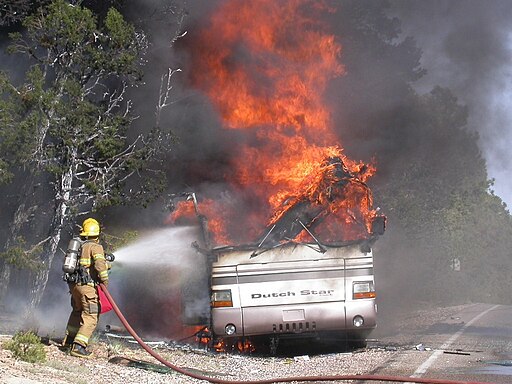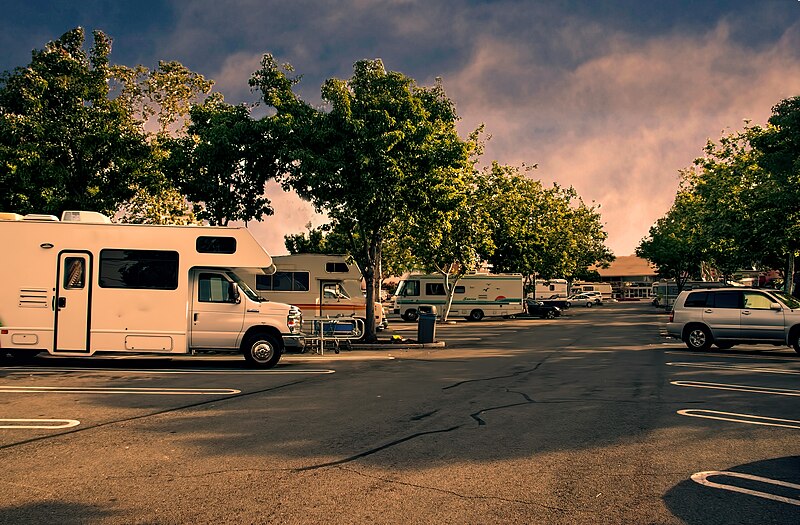- calendar_month October 24, 2023
Over the last five or so years, every Angeleno has experienced that moment when, frantically searching for street parking, they turn onto a stretch of road completely saturated with recreational vehicles, better known as RVs. For several reasons, these unauthorized RV camps have become a precarious facet of life in LA. Many of these permanent RV dwellers outright own their homes on wheels. But there’s also a number who rent their RVs from “vanlords” for anywhere between a few hundred to $1,000 a month. Mayor Karen Bass has made the dissolution of these streetside RV camps a priority of her administration. But with so many RV dwellers considering themselves perfectly housed, the mission has been challenging to say the least.
Where Did All These RVs Come From?
In 2019, there were about 10,000 people living in their vehicles across Los Angeles County. Today, that number’s closer to 14,000 per the Los Angeles Homeless Services Authority. Why the surging popularity in mobile “homes”? We’re sure you already have a few guesses.
As with so many big city problems, there are a variety of factors at play in the surge of these makeshift RV camps. Chief among them: a profound shortage of affordable housing units. Propped up by the NIMBY movement, LA’s elected officials spent years stymying or completely halting new construction.
The result? A sprawling city of soaring rents, empty luxury apartment complexes, and million dollar homes. The RV provided a sort of limbo between legitimate shelter and sleeping on the sidewalk. Of course, there was always the city’s parking enforcement with which to contend.
Well, at least until January 2021. That’s when city officials deemed it unsafe to tow lived-in vehicles amidst a global pandemic that showed no signs of letting up. These COVID-era protections lasted for about a year. And by then, the RV camps had become such a fixture that breaking them up wasn’t as simple as calling a tow truck.
A Diversity of RV Dwellers
In many cases, the denizens of these RVs were people who took care of their vehicles and themselves, posing no threat or even inconvenience to their surrounding neighborhood. These were people with steady jobs who had been priced out of a city where the median rent for a one-bedroom apartment was $2,500.
Then, there were those RV dwellers who succumbed to rampant drug use, crime, and general disrepair, leaving their housed neighbors feeling suddenly unsafe. Complaints poured in about human waste in the streets, needles in the nature strips, chemicals in the gutters… and even the occasional RV fire.
The Civic Response to Unauthorized RV Camps
So far, Mayor Bass’s administration has swept through dozens of tent encampments as part of the Inside Safe initiative. A similar program, Pathway Home, recognizes RV dwelling as a type of homelessness; a view not always adopted by the dwellers themselves. Representatives of Inside Safe have been moving tented individuals into temporary accommodations. Pathway Home offers similar incentives to residents of these RV camps.
For example, dwellers of an RV encampment on Jasmine Avenue were offered $500 gift cards and a motel room earlier this year. But they were also advised to allow the city to tow and demolish their RVs. Few took them up on this latter part of the deal.
Photo credit: Grand Canyon National Park
Yet, the city is persistent, setting aside even more funding for intervention programs specifically focused on people who choose to reside in their vehicles. City Council are even tackling the mysterious vanlords, having recently drafted an ordinance aimed at cracking down on individuals renting decrepit RVs to desperate “tenants.”
The High Cost of Rehousing
But the official efforts are far from perfect. Currently, a city-authorized temporary tent city is under scrutiny for its exorbitant expenses. With each individual tent costing an estimated $44,000 and an additional $4 million price tag for staffing facilities, bathrooms, and a fence, it becomes obvious that cost is not the main concern.
Yet, Bass has made it clear she doesn’t want to leave any unhoused people in a worse situation, stating “literally five people a day die on our streets.” And expedited service comes at a cost. The temporary tent city also costs an additional $3 million per year to provide round-the-clock staffing as well as catering services. Eventually, permanent public housing will replace the tent city. But that’s years in the making. In the meantime, Bass wants to make sure these unhoused individuals have adequate shelter.
Is an RV Dweller Homeless?
Photo credit: bluesbby
However, not all RV dwellers see themselves in the same boat as those populating Bass’s tent city. Some legitimately view their RV as home sweet home. And offers of hotel rooms and gift cards aren’t going to change their minds.
To their credit, there is no guaranteed move-in date for permanent housing if they kiss their RV camps goodbye. And many worry that if they give up their one shred of security, they’ll find themselves in an even worse situation. After all, most know someone who the system has failed… if they haven’t been failed by it themselves.
Perhaps this fear presents the biggest roadblock to breaking up these unlawful RV camps. The RV dwellers aren’t always willing to leave. Some of these RVs squat on wheels that haven’t moved in years. Maybe they couldn’t even move at this point. It lends to a familiarity that promotes feelings of home.
The Long Road Out of the RV Camps
Photo credit: Envato
The city has been putting an emphasis on towing away any RVs that are inoperable, unregistered, or deemed hazardous. But it’s not as simple as calling the closest tow truck. Cumbersome RVs require specialized tow trucks which are in short supply. And even if this wasn’t an issue, there’s still no plan on where to store the impounded RVs.
For those suggesting destruction, it’s not as simple as you’re likely imagining. Or as cheap. Safe demolition of an RV costs approximately $9,000, owing to specialized procedures such as proper disposal of hazardous waste. The city has quickly learned that the only method of addressing its RV problem with any track record of success requires a lot of coordination and effort. This means trained program representatives, law enforcement officers, sanitation workers, towing companies, and more executing a tightly choreographed dance with no room for error.
But ultimately, it all comes back to the need for more affordable housing in Los Angeles. Which means construction needs to move forward. Just think of it this way: the sooner rents drop, the sooner the RV in front of your home will be gone. And even the staunchest of NIMBYs would have to agree with that.



